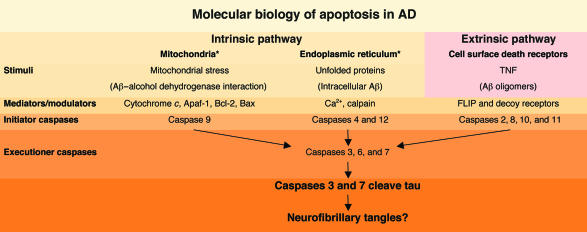Figure 2.
The interface of the two major molecules implicated in AD pathogenesis with molecular mechanisms of apoptosis. The two major pathways to cellular apoptosis are intrinsic and extrinsic. The extrinsic pathway involves signaling through cell surface death receptors, such as the TNF receptor, which are regulated by decoy receptors and Fas-associated death domain–like interleukin-1β–converting enzyme inhibitory proteins (FLIPs). Direct binding of Aβ or Aβ oligomers to death receptors remains to be shown, but the pattern of activation of downstream caspases (e.g., caspases 2 and 8) supports involvement of the extrinsic pathway in Aβ-mediated apoptotic processes. Alternatively, intracellular Aβ produced in the ER may lead to ER stress, or binding of Aβ to a mitochondrial alcohol dehydrogenase may lead to mitochondrial stress. Both entries into the intrinsic pathway may activate downstream apoptotic mechanisms. While details of the upstream mechanisms and mediators remain to be defined, activated executioner caspases 3 and 7 are capable of cleaving tau protein, which may favor formation of NFTs. Asterisk indicates possible sites of action of Aβ. Caspases 1 and 5 are involved in cytokine activation.

